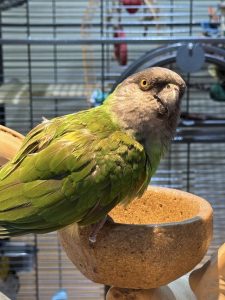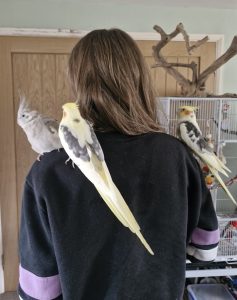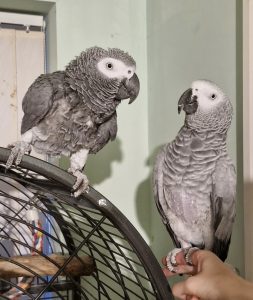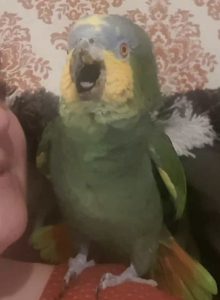
African grey
The African Greys are primarily … grey. They have a white area around the eye, and a red tail. There are two types of Greys, the normal Congo African Grey and the Timneh grey. The Timneh grey has a dull red tail. There is a third type of African Grey. They are 13 Inches in length and have a life span of 50 – 65 years.
There is no “sure” way to sex an African grey without blood DNA tests but some people say you can tell by the eyes. The Female has a more or an elliptical shape to the eye, whereas the males are more round but this is not 100% accurate.
Please if you have any-more questions or queries please do not hesitate to contact us.
Further information
African greys are known as the best parrot at mimicry and because of this are very popular as pets. Studies have shown that the Grey can actually understand and use human language. African greys can be very temperamental, and are known to be nippy. They have a tendency to pluck feathers if bored so lots of toys and time out of the cage is needed to keep them happy. They also bird tends to bond to one person within the family which can cause problems for the others in the house hold. There is nothing to suggest that a male is more “tame” than a female or vice verse.
African greys don’t tend to “scream” they are more known for constant household noises or talking, so in the screaming your house down level they are about a 3 but if the constant noise of your smoke alarm or car alarm is annoying to you then this number could rise in each person’s view!
African greys can be very loving birds if housed correctly, they do love to chew so have plenty of toys available for them. When people think of a plucked bird one of the main ones are African greys. This is because of their sensitive nature and the slightest change in your house can trigger the plucking, so it’s best to allow your grey to get use to change from a baby to avoid any upset.
African greys normal start mating in October, they then lay eggs in November they lay between 3-4 and after 28 incubation they hatch in December.
African greys need special consideration of their calcium level. This subject is more complex than just feeding your Grey foods high in calcium. Giving extra calcium and not balancing it with phosphorus can also be very harmful. The best solution is to talk over your bird’s diet with a GOOD avian vet a list can be found on our “illness” page on the site.
Greys also have problems with tapeworms. It is a good idea to get your bird treated for tapeworms even if not identified in a faeces sample. Many such treated Greys pass undetected tapeworms after treatment.
Greys are on the “list” of species prone to catch PBFD.
There are 2 types of greys, the Congo African grey and timneh grey. Pictures of the 2 can be found at the bottom of this page. Timneh greys do have a reputation of being a bit harder to care for in the fact that they are generally more head strong, nippy and solitary birds.
African greys need an extra supplement of calcium to their diet it’s a great idea to talk this over with your vet during checkups. A good low sunflower seed mix diet is fine but this must be accompanied by fresh fruit and veg daily. Fruit and veg should not be a treat but the norm! A good multi vitamin is also a must for complimenting their diet to ensure they are getting all they need.
More information
Read more about other parrot species
30+
years experience between our members
30+
years experience between our members
30+
years experience between our members
Our feathered friends
Looking for new homes
From loving tickles to lifelong friend












